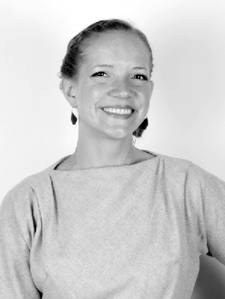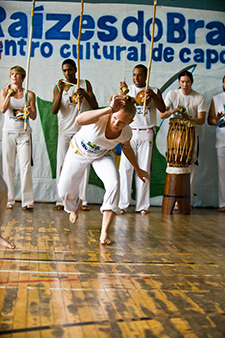CAA News Today
Staff Interview: Katie Apsey
posted Dec 19, 2016

Katie Apsey
The next in a series of interviews with staff members is a conversation with Katie Apsey, CAA manager of programs.
How long have you worked at CAA?
I have worked at CAA just over one year now. I originally started in the Publications Department as data coordinator for the graduate-school directories and moved over to the Programs Department when Lauren Stark left her position to pursue work in the archives field.
What do you do at CAA?
Many different things! I do the administrative work for all programs related to the conference: session submissions for the Annual Conference Committee’s review, ARTexchange applications, submissions to the various conference publications and the conference website, special events, business meetings, poster sessions, appointments for mentoring sessions, and more! I also help the juries for the annual Awards for Distinction as well as the conference travel grants. Both are quite rewarding.
What does CAA mean to you?
I became a member of CAA long ago when I graduated with a BA in photography and was searching for my first job. At that point in my career, membership was a way for me to determine the state of the field—what kind of jobs and opportunities and career paths there were for me as a young artist. As my career shifted away from art practice and toward museum work and then art history, CAA became a network for keeping up with peers rather than a resource for the job market.
Can you talk about one of your favorite member moments?
It would be too hard to pick one moment of engagement with a member. While working in the Speaker Ready Room I overhear amazing conversations between session chairs and their speakers while they prepare before or recombobulate after their sessions. Observing the uniqueness of each group and noting the different approaches that session chairs take when creating thoughtful panels is equally inspiring. I always learn things about new theories, historiographies, artists, and exhibitions through osmosis while I am running around doing management tasks!
What do you like best about the arts and working in the arts?
This sounds so cliché, but I like being surrounded by creative people and getting inspired and challenged by them: people who know that the “right” or “best” answer is an ambiguous, moving target; people who, after they are done with the business of an email, send me a link to an article, exhibition, or artist’s webpage; people who know the value of thinking deeply or uniquely; and people who do what they do not for the money but for their belief in the importance of discourse.
Do you have a favorite moment from the Annual Conference?
When I attended as a regular member, my favorite moments were seeing my academic heroes speak or listening to the annual Distinguished Artist Interviews. Now that I work for CAA “behind the scenes,” my favorite moments have become working with the room monitors onsite. These are the people that check conference badges at the doors to session rooms. I enjoy hearing what they are working on with their art or scholarship, pointing them toward sessions they may have overlooked in the program, and taking in the stories of the retired professors who are volunteering their time.
You are writing your dissertation on Native American art, and the CAA office is up the street from the Smithsonian Institution’s National Museum of the American Indian (NMAI). Have you visited the museum often since working here?
Yes, I feel very lucky to be so close to the museum’s New York branch. One of the main curators there, Kathleen Ash-Milby, is a powerhouse who focuses on contemporary Native American art, which is what I write about most often, so I value seeing the exhibitions at the George Gustav Heye Center as soon as they open. The museum also has the film and media center with rare digital content and a cozy educational library that I like to visit on my lunch break. It is the perfect spot for even fifteen minutes of reading outside the office, or for watching a VHS tape from the NMAI collection of performances that hasn’t been digitized yet! A lot of tourists visit lower Manhattan, but many of them don’t know they can go inside the Customs House—the building that houses the museum—for free, so it still remains a quiet refuge with rotating exhibitions and frequent nighttime events. In fact, I attended a MuseumHue event there about art and social change just a few weeks ago!

Katie Apsey practices the Brazilian martial art of capoeira (photograph provided by Capoeira Vida)
You have performed and taught dance. What are your specialities and favorites?
Oh, I could go on for hours about this. I love whatever classes I can take. As a company dancer, I felt like contemporary dance challenged me the most intellectually. It really pushes the boundaries of expansive concepts like “movement,” “performance,” and “choreography.” Closer to my heart, though, are samba dance and the Brazilian martial art of capoeira, both of which feed my soul. Samba is physically demanding yet joyful and amazingly fun to perform. I love looking into the crowd from the stage and seeing hundreds of people smiling back or even dancing themselves because they can’t sit still. Conceiving of and making new costumes uses my creativity in a different way.
There are many types of samba—including carnival mas group/Rio-style samba, Bahian-style samba de roda, and Orisha dances associated with Candomblé—that speak to different needs, abilities, histories, lives, and energies. Dance is an art form that grows with a person over time and answers their needs in the moment. Capoeira is the same way. It is actually a martial art, not dance. It challenges both my body (I swear someday I will still be able to learn a back flip … in my thirties) as well as my mind (in the strategy of the game). Capoeira even challenges my musical abilities in having to learn all the songs and instruments while trying to sing in tune!


